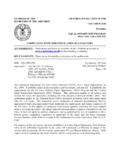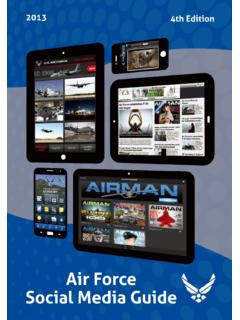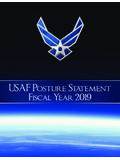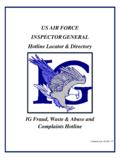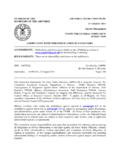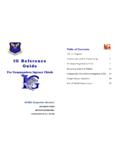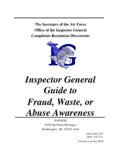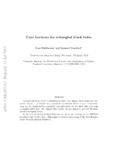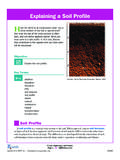Transcription of Autonomous Horizons - final - af.mil
1 Distribution A. Approved for public release; distribution is unlimited. Public Release Case No 2015-0267 ! Autonomous ( Horizons !System'Autonomy'in' the'Air'Force' !A"Path"to"the"Future!Volume!I:! !Teaming! United'States'Air'Force!Office&of&the&Ch ief&Scientist! AF/ST!TR#15"01!June%2015 !ii Autonomous ! Horizons Distribution A. Approved for public release; distribution is unlimited. Public Release Case No 2015-0267 The views expressed in this document are those of the Air Force Office of the Chief Scientist and do not necessarily reflect the official policy or position of the Air Force, the Department of Defense, or the Government.)
2 The Office of the Chief Scientist serves an advisory role within the Air Force and does not make decisions regarding official Air Force policy or positions. Autonomous ! Horizons iii Distribution A. Approved for public release; distribution is unlimited. Public Release Case No 2015-0267 Office of the USAF Chief Scientist DEPARTMENT OF THE AIR FORCE HEADQUARTERS OF THE AIR FORCE WASHINGTON DC 1 June 2015 America s Air Force: A Call to the Future provides a compelling 30-year vision for ensuring that the Air Force can continue to provide responsive and effective Global Vigilance Global Reach Global Power.
3 Creating innovative game-changing technologies that are agile and able to amplify many of the enduring attributes of airpower speed, range, flexibility, and precision form a critical portion of this vision. Unmanned systems and Autonomous software offer significant potential advantages for meeting the challenges of a newly forming adversarial environment. Speed of light cyber-attacks, anti-access/area-denial (A2SD) actions that keep our forces operating at a distance, and potential attacks on our space-based assets all require innovative solutions for maintaining mission-effective air, space and cyber operations in the face of these new challenges.
4 Autonomous Horizons depicts a path to the future for system autonomy in the Air Force. It describes an evolutionary progression that obtains the best benefits of Autonomous software working synergistically with the innovation of empowered airmen. This vision is both obtainable and sustainable it leaves the authority and responsibility for warfare in the hands of airmen while creating tools that enhance their situation awareness and decision-making, speed effective actions, and bring needed extensions to their capabilities. Rather than attempting to design the airman out of the equation, the Air Force embraces the agility, intelligence and innovation that airmen provide, along with the advanced capabilities of autonomy, to create effective teams in which activities can be accomplished smoothly, simply and seamlessly.
5 In order to thrive in the future, we must pursue strategic agility in our people and in our technology. New paradigms of operation are needed to maintain the strategic advantage for our Airmen, our Air Force, and our Nation. Autonomous Horizons provides a pathway to the future for Air Force systems to ensure our ability to fly, fight, and win in air, space, and cyberspace. Mica R. Endsley Chief Scientist United States Air Force iv Autonomous ! Horizons Distribution A. Approved for public release; distribution is unlimited. Public Release Case No 2015-0267 Executive Summary Autonomous systems provide a considerable opportunity to enhance future Air Force operations by potentially reducing unnecessary manning costs, increasing the range of operations, enhancing capabilities, providing new approaches to air power, reducing the time required for critical operations, and providing increased levels of operational reliability, persistence and resilience.
6 Increased levels of autonomy can be brought to bear to enhance operations in both manned and unmanned aircraft, and in operations in space, cyber, command and control, intelligence, surveillance and reconnaissance, readiness, and sustainment across the Air Force. Autonomous Horizons serves to provide direction and guidance on the opportunities and challenges for the development of Autonomous systems for Air Force operations. This goal is to be addressed in three volumes. Volume I describes a vision for Autonomous systems that will work synergistically with our airmen as a part of an effective human-autonomy team where functions and situation awareness flow smoothly, simply, and seamlessly between them.
7 Volume II details the many technical issues involved in creating machine intelligence that can deal effectively with the challenges of uncertainty and variability in operational environments. Volume III will address key issues associated with cyber security and reliability, communications links, and command and control systems to support Autonomous vehicles, as well as issues in the development of Autonomous systems, including verification and validation of autonomy software and hardware. In this first volume, a summary of the challenges of automation and autonomy for airman interaction are presented, based on some four decades of experience and research on this issue.
8 These include (1) difficulties in creating autonomy software that is robust enough to function without human intervention and oversight, (2) the lowering of human situation awareness that occurs when using automation leading to out-of-the-loop performance decrements, (3) increases in cognitive workload required to interact with the greater complexity associated with automation, (4) increased time to make decisions when decision aids are provided, often without the desired increase in decision accuracy, and (5) challenges with developing a level of trust that is appropriately calibrated to the reliability and functionality of the system in various circumstances.
9 Given that it is unlikely that autonomy in the foreseeable future will work perfectly for all functions and operations, and that airman interaction with autonomy will continue to be needed at some level, each of these factors works to create the need for a new approach to the design of Autonomous systems that will allow them to serve as an effective teammate with the airmen who depend on them to do their jobs. In this vision of the future, Autonomous systems will be designed to serve as a part of a collaborative team with airmen. Flexible autonomy will allow the control of tasks, functions, sub-systems, and even entire vehicles to pass back and forth over time between the airman and the Autonomous system, as needed to succeed under changing circumstances.
10 Many functions will be supported at varying levels of autonomy, from fully manual, to recommendations for decision aiding, to human-on-the-loop supervisory control of an Autonomous system, to one that operates fully autonomously with no human intervention at all. The airman will be able to make informed choices about where and when to invoke autonomy based on considerations of trust, Autonomous ! Horizons v Distribution A. Approved for public release; distribution is unlimited. Public Release Case No 2015-0267 the ability to verify its operations, the level of risk and risk mitigation available for a particular operation, the operational need for the autonomy, and the degree to which the system supports the needed partnership with the airman.
